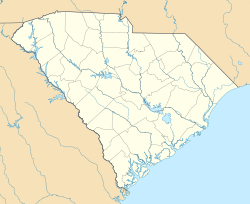
Horry-Guignard House is a historic home located at Columbia, South Carolina. It was built before 1813, and is a two-story, late Federal style, modified I-house type frame dwelling. The front facade features a one-story, full-width balustraded porch supported by square columns. During the winter of 1813–1814, the main hall was widened from six feet to eleven feet. To do this, the house was sawed in half and the two ends were pulled apart to rest on two new foundations. It was probably built by Peter Horry (1747-1815), a Revolutionary War Colonel and Brigadier General of the South Carolina Militia. Later, the house was acquired by John Gabriel Guignard (1751-1822), the Surveyor General of South Carolina from 1798 to 1802. Guignard is responsible for the early design of the city and laid out the first streets of Columbia.

Sylvan Building, originally known as Central National Bank, is a historic commercial building located at Columbia, South Carolina. It was built in 1870, and is a three-story, brick Second Empire style building designed by Samuel Sloan. It features a slate-covered mansard roof.

Building at 1210–1214 Main Street, also known as Capitol Café, is a historic commercial building located at Columbia, South Carolina. It was built by 1871, and is a two-story, seven bay, stuccoed brick building. A cast-iron railing extends across central three bays of the second floor. The Capitol Café was previously located in the building since 1913.

The Bouchier Building is a historic commercial building located in Columbia, South Carolina. It was built in 1913–14, and is a three-story, terra cotta faced building with large areas of glass on the upper floors.

Lever Building is a historic commercial building located at Columbia, South Carolina. It was built in 1903, and is a three-story building faced with brown brick and terra cotta.

Consolidated Building is a historic commercial building located at Columbia, South Carolina. It was built in 1912, and is a two-story building faced with elaborate colored and glazed terra cotta. The second floor features a central tripartite round-headed window.
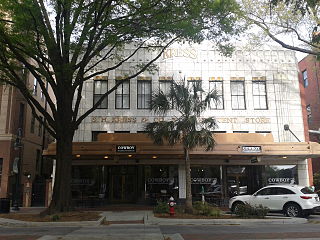
Kress Building is a historic commercial building located at Columbia, South Carolina across the street from the Columbia Museum of Art. It was built in 1934 by S. H. Kress & Co., and is a two-story, Art Deco style building faced with white terra cotta and colored terra cotta ornamentation. It features rounded storefront windows and cornice that contains the word "Kress" and surmounted by a stepped parapet.

National Loan and Exchange Bank Building, also known as the Barringer Building, is a historic bank and office building located at 1338 Main Street, Columbia, South Carolina. It was built in 1903, and is a 12-story, steel frame building faced in brick and stone. It measures 184 feet high and is considered Columbia's first skyscraper. The building was owned by the Barringer Corporation from 1953 until 1974.
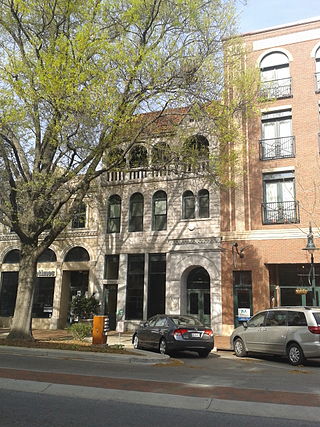
Canal Dime Savings Bank, also known as Eckerd's Drug Store, is a historic bank building located at Columbia, South Carolina. It was built between 1892 and 1895, and is a three-story, Romanesque Revival style brick building with a granite façade and red barrel tile roof. The building was purchased by Eckerd's Drug Store in 1936.
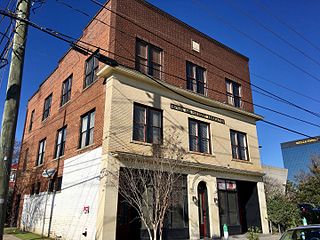
North Carolina Mutual Building, also known as the Blue Palace Tea Shop and Barber Shop, is a historic commercial building located at Columbia, South Carolina. It was built in 1909 by the North Carolina Mutual Life Insurance Company, and is a three-story, rectangular, brick commercial block. The building housed African-American businesses, professionals, and institutions during the years of Jim Crow segregation. It is located in the Washington Street business district, the city's black downtown.

Confederate Printing Plant is a historic industrial building located at Columbia, South Carolina. It was built in 1864, and is a large two-story, Greek Revival style brick structure. Originally it was a one-story structure, but enlarged to two-stories after the building was burned in February 1865 by General William Tecumseh Sherman’s army. It was built by the Evans and Cogswell Company for the manufacture of Confederate bonds and other printing purposes. During the 20th century, it was used as a liquor warehouse by the South Carolina Dispensary and is presently used as a Publix grocery store and residential condominiums.

Richland Cotton Mill, also known as Pacific Mills, Lowenstein Mill, and Whaley's Mill, is a historic cotton mill building located at Columbia, South Carolina. It was built in 1894, and is a four-story, rectangular brick mill building. It features a seven-story stair tower, with a circular vent flanked by two arched vents. Attached to the building are an engine room, a boiler room with chimney, and a machine shop.

Olympia Mill, also known as Pacific Mill, is a historic textile mill complex located at Columbia, South Carolina. It was built in 1899, and consists of a four-story, red brick, rectangular shaped, main mill building connected to a one and two-story red brick power plant. The main building is in the Romanesque Revival style and features terra cotta detailing, large segmental arched window openings, and twin pyramidal roofed towers. The complex also includes: a one-story brick power plant auxiliary building, a one-story storage building, and two small brick one-story gatehouses.
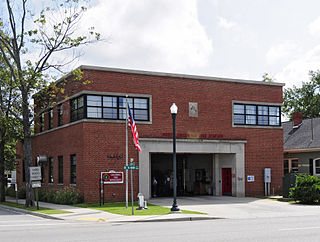
North Columbia Fire Station No. 7 is a historic fire station located at Columbia, South Carolina. It was built in 1948, and is a two-story, brick, transitional Art Moderne / International style building. It features metal window frames, flat roof, and corner ribbon windows.

Harden Street Substation, also known as Harden Street Fire Station, is a historic fire station located at Columbia, South Carolina. It was built in 1953, and is a two-story, rectangular brick building with a flat roof constructed in the Moderne style. It was built by the city of Columbia to house African-American firemen under white officers and maintain institutional segregation.

Columbia Central Fire Station, also known as Columbia Fire Department Headquarters and Senate Street Station, is a historic fire station located at Columbia, South Carolina. It was built between 1949 and 1951, and consists of two buildings and a structure. The main building is a two-story, rectangular, brick building in the Moderne / International Style. It has a flat roof and features horizontal bands of windows. The one-story, brick fire truck garage building and the main building were constructed in 1949–1950. The drill tower is a six-story reinforced concrete structure built in 1951. The complex served as the Columbia Fire Department's Headquarters from 1950 until 1995.
West Gervais Street Historic District is a national historic district located at Columbia, South Carolina. The district encompasses 40 contributing buildings in a commercial, warehouse, and light industrial section of Columbia. They date from about 1846 to the 1930s. Notable buildings include the W. H. Gibbes Machinery Co. and Carriage Works, Seaboard Air Line Railroad Passenger Depot, and Seaboard Air Line Railroad Baggage Room.

Columbia Historic District II is a national historic district located at Columbia, South Carolina. The district encompasses 113 contributing buildings and 1 contributing site in a former residential section of Columbia. They were built between the early-19th century and the 1930s and are now mostly used for commercial purposes. The buildings are in the Greek Revival, Gothic Revival, Classical Revival, and the “Columbia Cottage” styles. Notable buildings include the Robert Mills House, Debruhl-Marshall House, Hampton-Preston House, Episcopal Church of the Good Shepherd, Crawford-Clarkson House, Maxcy Gregg House, Hale-Elmore-Seibels House, St. Paul's Lutheran Church, and Ebenezer Lutheran Church.

Efird's Department Store, also known as Lourie's Department Store, is a historic department store building located at Columbia, South Carolina. It was built about 1870, and is a rectangular brick building renovated and expanded in 1919. This included the addition of a third story and the installation of a new brick façade and store entrances. Between 1919 and 1958, it housed the Columbia branch of the Charlotte, North Carolina based Efird's Department Store chain. It currently houses a Mast General Store, which moved in on May 25, 2011.

